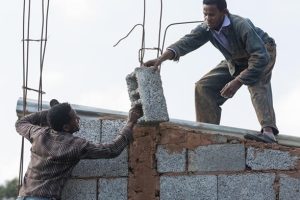Astronomic scientists say that the earth, during the time of its creation, had gone through a cosmic cleansing which brought a period of meteor shower that burned the earth with volcanic lava. In most places of the northern parts of Ethiopia, one could see landscapes that look like solid reflections of the earth’s painful times of the abovementioned period.
Everywhere you look you may see vast land full of rocky mountains that seem not easier to be conquered by human beings. But this mountains have once submitted to an ancient king of Ethiopia, who have left his long lasting architectural wisdoms on them. He was a king who had bought a massive land from a local lady to construct the greatest and magnificent rock hewn churches, one of UNESCO registered world heritages.
This king was called Lalibela, whom the churches are named after. “Kings could just take whatever land they want from whoever has owned it. But king Lalibela was not the same. He was a holy king and he wouldn’t just take a land from a lady just because he was the king. He would rather buy the land from her with decent price and started hewing the rocks coming down from a hill where he lived in a tent few kilometers away around 200AD,” a local tour guide Zeryihun Arega told The Ethiopian Herald.
Step by step and improving his designs from time to time, he built eleven churches within twenty three years, which still are center of tourist from all parts of the world. Tourists come every day the whole year and visit the churches but the Bete Georgies always fascinates them, said Zeryihun. “It creates some kind of feeling that they mostly don’t describe and they seat near to it and spend more than an hour with silence.
I think it is because of its unique architectural design,” he noted. Melanie Kneisel and Evan Altmlv, are tourists from US America and both software developers. They also told Herald that it was their first time to Ethiopia and been only for days in the country.
They unfortunately missed the religious ritual which, was held few days before they arrived at Lalibela Town. It is one of the biggest ceremonies in the country. This ceremony is held every year beginning with different rituals beginning from the eve to the day of Xmas, in Lalibela, particularly the church of Bete Medhanialem. Meanwhile, both Melanie and Evan have been enjoying their time and they said the artifacts and ancient history of the heritages are very amazing. “It is one of the most beautiful places I have ever been,” noted Melanie.
In terms of infrastructure and preservation of the heritages they both agree that governments who have been engaged in and the global community have to continue their contribution. In this case, the current situation of rock hewn churches of Lalibela has been triggering the attention of different international communities and governments. These heritages aging over eight hundred years are now in danger of natural disaster and lack of effective preservation techniques.
Despite the efforts made by the government and partners to preserve the heritages and hand them over to the coming generations, the damages seem to create a curiosity in the minds of the residents of the old city, Lalibela. Some of them say the heritages are not having the appropriate maintenance and some of them are even on the course of destruction because of negligent maintenance services. Bete Medhanialem, Bete Urael and Bete Michael churches are the examples the tour guides and residents mentioned. The residents are very worried about the heritages more than any time and their economy depends on tourism directly or indirectly.
The best example that this writer discovered was a young women who was a college graduate and have been unemployed. Her name is Manyahilosh Channe. She started her own business with a very small capital and gradually opened her own Cafeteria and restaurant. She said the tourism sector is benefiting her directly or indirectly.
The tourists may come straight to her house and spend their money. If not the tour guides will do. That means the money will come to her one way or another. Therefore, the existence of the Lalibela churches is the existence of this community and most of all it is the existence of world’s top rated historical, cultural heritage and foot print of early civilization. This is why governments and the global community have to put hands for its conservation. Prime Minister of the Republic of Ireland Leo Varadkar with the Ethiopian Minister of Culture and Tourism Dr. Hirut Kassaw have paid the Lalibela Churches a one day visit on Thursday.
During the visit Varadkar said the rock hewn churches of Lalibela are the reflections of Ethiopia’s enormous historical heritages which he always wanted to visit beginning from his childhood times. As part of the ongoing bilateral relationship between Ethiopia and Ireland, agreements are being made on different aspects including a series of experience sharing between the two countries focusing on tourism and rural job creation from the sector. His government would start working with the Ethiopian government in preserving and protecting the world heritages, according to the Prime Minister. Dr. Hirut for her part said that there are plans to improve the sector and greening the Lalibela churches with lights for better top view at night times is also part of the plan.
Herald January 12/2019
BY HENOK TIBEBU





